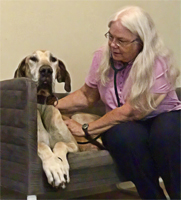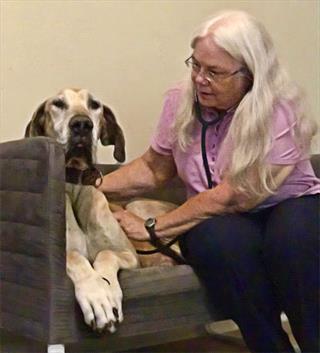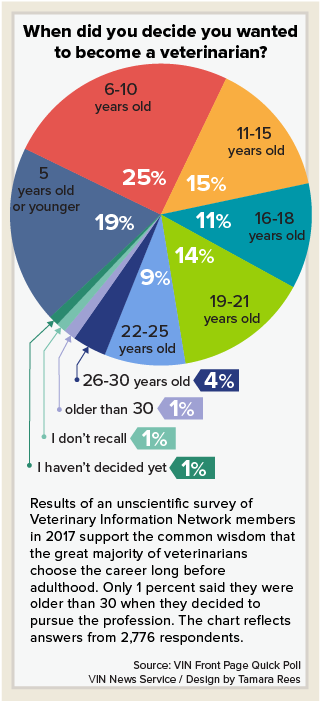

Photo by Jonathan Sampson
Dr. Kathryn Jones began practicing veterinary medicine two years ago at age 60. She believes the worries she has as a new practitioner are no different from those of her younger counterparts: "A little bit of imposter syndrome, a little anxiety of ‘Could I have done more for the pet?’ ”
As a veterinary student in her late 50s, Dr. Kathryn Jones knew that age set her apart from fellow classmates. But Pudge the goat really drove the point home.
Jones encountered Pudge as part of a large-animal rotation during her final semester at Tuskegee University College of Veterinary Medicine. The nanny goat had a reputation for being cantankerous but Jones had had no trouble with her.
That changed one day in March 2016. It was her turn to feed Pudge and change the hay in the stall. As soon as she entered the 10-foot-by-10-foot enclosure, the goat charged, head-butting Jones just below the knee. She fell to the ground in excruciating pain. Pudge stood ominously near the entrance. That meant “I couldn’t get out,” Jones recalled.
Pudge raced toward Jones again, stopping just short of ramming her a second time. Hearing her cries for help, classmates came to Jones’s rescue. An X-ray showed no broken bones but her knee swelled up, hobbling her for days.
Relating the story by phone from her home in North Carolina, Jones said the experience crystalized a major decision about her upcoming career: She would not be treating large animals.
As someone entering the profession in late middle age with slower reflexes, Jones figured she might fare worse with the next bucking, kicking or ramming creature. But as for sticking with veterinary medicine in general, there was no question. In fact, Jones believes that age has been in most ways a benefit in her second career.
Older new practitioners are a rare subset of veterinarians: In 2016, the year Jones graduated, 0.1 percent of 3,521 new veterinarians were age 51-60, according to figures from the American Veterinary Medical Association. It was a typical year. From 2001 through 2017, the number of new veterinarians age 51-60 each year never surpassed 0.3 percent.
Among a sampling of members in the Veterinary Information Network, an international online community for the profession, only 33 individuals were age 51 or older when they obtained their veterinary degrees. That’s out of 18,781 members for whom birth year and year of graduation were available for analysis. (VIN is composed overall of more than 63,000 veterinarians and veterinary students.)
Entering the field late is particularly rare for veterinarians, most of whom reputedly decided their occupation very young. An unscientific poll by VIN last year tells the story: 70 percent of respondents knew by age 18 that they wanted to become a veterinarian. Nineteen percent decided at age 5 or younger. (The figures reflect 2,776 responses.)
Seizing the option
Perhaps not surprisingly, Jones’s path into the small society of veterinarians who start practicing in middle age didn’t follow a straight line. Jones dropped out of college at 18 when she became pregnant with her first child. She went on to have three children, marry twice and work more than 30 years for the U.S. Postal Service, the last dozen as a dispatcher of mail-delivery trucks. Along the way, she raised or fostered dozens of rescue animals.
When her husband of 23 years died in 2005, Jones was unmoored. Age 49 at the time, she eventually regrouped by focusing on the future and unfinished business.
“It still kind of tugged at me that I still wanted a degree, and as I spent more and more time with the animals, I really wanted to do something in assisting in the help of these animals,” she said.
So while working full-time at USPS, she began in 2007 to take night classes in animal science at North Carolina Agricultural & Technical University.
When in 2009, the postal service offered her a chance to retire early, she jumped. “As I was in the middle of my second semester of organic chemistry, I thought it would be a good time to go,” Jones said wryly.
Free to pursue her studies full-time, she loaded up, double-majoring in animal science and laboratory science and minoring in psychology. Up to that point, she hadn’t thought of becoming a veterinarian. Instead, her sights were on lab-animal management, shelter management, or research in animal nutrition or behavior.
But in her final year of undergraduate work, an adviser prodded Jones to consider veterinary school. That’s how she came to apply to Tuskegee. “It came to me late as an option and I just seized it,” she said, adding pointedly, “It and the student-loan debt.”
Like the vast majority of veterinary-school graduates, Jones borrowed a lot of money to obtain the education. Her student debt is nearly a quarter-million dollars. Unlike her colleagues, Jones has a pension from the Postal Service to cover the costs of everyday life. She manages the debt through a payment plan keyed to her income.
Still, money’s tight. Jones owns a mobile practice franchised by Heal House Call Veterinarian. Only two years out of school, she’s still building the business, working 18 to 20 hours a week at the moment. To supplement her income, she vaccinates animals several days a month for VIP Pet Care, a company that operates preventive-care clinics hosted by local pet stores.
Jones figures the school debt will outlast her. “I will probably never live long enough to pay it all off,” she said, but not fretfully. Age, Jones noted, has a way of mellowing your outlook.
Another advantage she’s found in age is patience and tolerance. In school, for example, she saw herself displaying more tolerance than her younger classmates — “being able to see things from a different perspective and to acknowledge that there are different ways to accomplish the same goal,” she explained. She attributes the quality to lessons learned while raising three children.
Jones continues to exercise patience in her practice. She recently spent 2½ hours with an owner who had four anxious dogs. “That appointment was spent evaluating the behavior and developing a sedation/anti-anxiety protocol for subsequent visits,” she said.
It’s a work in progress, she reported, noting dryly that “The only visible outcome of that first appointment was a reduction in the number of treats in my vet bag.”
Not that she’s complaining. “This is the sort of situation that I anticipated when I started an in-home service,” Jones said. “While I really hope to achieve a busy practice, I truly hope that I am never too busy to give a client and their pets exactly what they need — even if it involves a bit more time.”
Eventually, Jones sees herself working at her mobile practice 40 to 60 hours a week. At a point in life when many others anticipate winding down, she relishes the prospect of much longer hours. “It would beat sitting here twiddling my thumbs, watching reruns of ‘All in the Family’ or ‘The Rockford Files’ or ‘Gunsmoke,’ ” Jones said.
‘What took you so long?’
It took getting burned out on the world of high-tech for Dr. Greg Closter to make a living from his interest in biology and love for animals.
With undergraduate degrees in journalism and psychology, Closter started out as a technical writer in the computer industry, moving on to graphic user-interface design for software, and digital graphic design and website design. By his mid-40s, he’d had enough.
Dr. Greg Closter

Photo courtesy of Wasilla Veterinary Clinic
Dr. Greg Closter was 51 when he became a veterinarian. His advice to those considering a similar late start applies to anyone at any age: “Make sure you are OK with the monetary issues — expensive education, ridiculously high student-loan obligations. If you are OK with that, then, by all means, follow your passion.”
“I … was looking for something more challenging and fulfilling,” Closter recalled in interviews by email. “I was always interested in the biological sciences. When I was looking for a career that could incorporate some of this, as well as allow flexibility as to where to get a job/live, veterinary medicine bubbled to the top.”
Would friends and family laugh at his idea? he worried. They didn’t. “They were all 100 percent supportive,” Closter said. “Most of the comments I got were along the lines of, ‘Well, it’s about time. What took you so long?’ ”
Closter and his wife, Denise, lived in Maine at the time. Completing pre-requisite courses for veterinary school entailed commuting to the University of Maine School of Animal and Veterinary Sciences in Orono, an hour’s drive away. He made the trip three or four times a week.
“I was able to schedule most of my classes in the morning. I would then come home and work in the afternoon, and use my evenings to do any homework. I did this for three years,” he recounted.
Accepted into veterinary school at the University of Minnesota in 2007, Closter and his wife packed their belongings in a U-Haul and headed west with three dogs and two cats. They had to rehome their five llamas.
As an older student, Closter found he was much more focused than he was as a 20-something. And he got the change of pace he’d been hankering for. “[E]ven though vet school was grueling at times, it was a welcome respite from the corporate world,” he said.
On the downside, it was difficult splitting his time between school, studying and family obligations. “Fortunately, my wife was very understanding and accommodating,” he said. “Essentially, while I was in vet school, we only saw each other at dinner, while walking the dogs and on weekends.”
Other disadvantages of being an older student: “Socially, although I had a great time with my fellow classmates, it would have been a lot more fun to be closer to their age. If I had become a veterinarian earlier, I likely would have pursued an internship followed by a residency, whereas I felt I needed to get a full-time job after graduating to support my family.”
And last but far from least, “[T]he student loans are a killer.”
Closter graduated with about $240,000 in school-loan debt. He’s currently on an income-based-repayment plan, which allows him to reserve some income for purposes other than loan payments but doesn’t much dent the loan principal. “This plan allows loan forgiveness after 25 years, so I will either have to work until I am 77 or die, whichever comes first,” he said with gallows humor. “In short, I’m screwed.”
Educational debt isn’t the only financial hit Closter and his wife took. They left Maine before selling their house, shortly before the Great Recession. “After almost two years of paying the mortgage when the house wouldn’t sell, we finally had to get rid of it via a short sale,” Closter said.
Upon graduating at age 51, Closter returned to Maine for a job at a small animal practice. But when his wife was unable to find employment in Maine, the couple embarked on a fresh adventure.
“I applied for a job in Alaska because Alaska was always somewhere I wanted to visit,” Closter said. He got the position. His wife was able to transition her job to Alaska (she’s a wellness coordinator for Blue Cross/Blue Shield), so they packed up a U-Haul and the pets — now four dogs and two cats — and drove up the Alcan Highway in December 2012.
Today, Closter works at a small animal practice owned by NVA in Wasilla, and despite the cost of becoming a veterinarian, his only regret is that he didn’t do it a long time ago.
“I like what I’m doing, and have no desire to retire anytime soon, so I just keep plugging away,” he said. “Yes, I wish the debt didn’t exist — it makes me nervous wondering about how I will manage when I do have the desire to retire — but aside from the government voting to help alleviate that debt in some manner, which I doubt will happen, I just have to live with it. Were I to live my life over again, I’d go to vet school right after undergrad.”
Love of cats propelled her
Looking back on the origin of her desire to become a veterinarian, Dr. Doris Lawrence cites a cat — specifically, a cat who died of feline infectious peritonitis. FIP is an incurable viral disease that’s difficult to diagnose. Research is advancing on promising treatments but in 1981 when Lawrence’s cat was stricken, little was known about the condition.

“It was a frustrating experience,” she said. She wondered, “Why in the hell don’t they know more about this?” and thought, “Well, I’d love to get into that business.”
At the time, Lawrence was deep into a career working behind the scenes in television broadcasting. She forgot about her idea of working in feline medicine. But by the late ’80s, Lawrence said, “Broadcasting got from being fun to being a pain in the butt. It was nothing but a bunch of egomaniacs, and the only way you could get a raise was to move from station to station.”
She started to think she should have done something else, and that old interest in veterinary medicine resurfaced.
She broached the idea with her husband, thinking he’d say, “Are you out of your mind?" Instead, he said, “If that’s what you want to do, then go do it.”
She was 45 at the time. The children were grown and out of the house. Lawrence began her venture methodically, getting a job as a veterinary assistant and attending school to become a credentialed veterinary technician as a way of finding out whether she truly was suited to the field.
To qualify for veterinary school, she had to complete certain prerequisites, which she did at The Ohio State University in Columbus, nearly two hours’ drive from her home in Cincinnati. Lawrence became what she calls a “weekend commuter,” living in Columbus during the week and going home on weekends.
Two years later, Lawrence applied to the veterinary school at Ohio State. “I almost passed out when they accepted me,” she remembered.
Her weekend-commuter life continued another four years. Lawrence was 52 when she graduated in 1998.
She knew exactly the type of practice she wanted to have: She wanted to work with cats, which she considers “God’s perfect creation,” and she wanted to make house calls because cats are notorious for resisting visits to the veterinarian.
Lawrence got a job with a clinic that fit the description but it wasn’t what she had envisioned. “For one thing, I had to do declaws,” she said.
After a few years, she left to start her own house-call practice, where she worked for the better part of 13 years, chiefly with cats. Lawrence retired late last year at age 72.
She’s still repaying student debt but the obligation is not onerous. Lawrence borrowed $65,000 in total, tapping savings to cover most of her school tab. Her monthly loan payments are down to a manageable $250.
Speaking of the advantages of entering the profession later, Lawrence said, “You have more life experience. You have better communication skills. … You’re sure of what you want to do.”
As for disadvantages? “Why,” she said, “you’ve got a shorter career.”